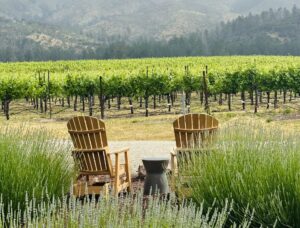Napa Valley Life Magazine, August 2023
The ribbon of vineyard-lined roadway from Napa Valley to Sonoma County (or vice-versa) is home to miles of history and exceptional wine in a relaxed, tranquil setting. The primarily two-lane rural Highway 12 winds through the birthplace of California wine country’s beautiful pastoral valleys framed by the Mayacamas and Sonoma Mountains. This area tells a story; the roots of its vineyards run deep, and the region’s wineries, some dating back to the 1800s, stand as testaments to a heritage that predates Napa’s emergence.
Highway 12 travels right through the town of Sonoma, not to be confused with the Sonoma Valley AVA or the larger Sonoma County that contains it all. Yes, the word Sonoma is confusingly repetitive, which may be why many people refer to all these simply as “Sonoma.”
SONOMA HIGHWAY
In 1983, Sonoma Valley became the first designated AVA in California, and today, it is considered the birthplace of California’s wine industry. It’s home to over 14,000 acres of vineyards and 80 wineries. The stretch of Highway 12 between Santa Rosa and Sonoma is known as the Sonoma Highway.
B.R. COHN WINERY
On Sonoma Highway, the charming B.R. Cohn Winery in Glen Ellen is beyond picturesque, especially in autumn during its Olive Oil Festival, with the rolling hillside vineyards of red, gold, and orange surrounding the winery. Spacious outdoor seating and a 160-year-old Picholine olive grove make for a glorious cinematic panorama. B.R. Cohn was founded in 1984 by Bruce Cohn, manager of the Grammy award-winning band The Doobie Brothers. With its beautiful estate, olive groves, and vineyards, B.R. Cohn is the perfect spot for events and for capturing stunning photos. Walk-ins are welcome, but reservations are required for groups of six or more.
S.T. FRANCIS WINERY & VINEYARDS
St. Francis Winery is another must-see on the Sonoma Highway. Upon entering, visitors first notice the winery’s stunning mission-style bell tower. The winery is named after St. Francis of Assisi and hosts a Blessing of the Animals fundraising event each fall to support animal charities. The family-owned and operated winery emphasizes quality winemaking and sustainable practices.
They produce wines from Bordeaux grape varieties, such as Cabernet Sauvignon, Merlot, and Cabernet Franc. The winery offers extensive culinary experiences and pairings prepared by Executive Chef Peter Janiak. Options like Parsnip Bisque and Five Spice Pork Belly make St. Francis an excellent lunch and winetasting spot. We highly recommend the vineyard trolley pedal tour, but reservations are needed.
LANDMARK VINEYARDS
Kenwood’s Landmark Vineyards is known for its artisanal Chardonnay and Pinot Noir. Founded by the great-great-granddaughter of John Deere, the winery’s history and ownership are explained during a winery and barrel room tour with the winemaker, Greg Stach. The estate’s Reserve Tasting comprises a line-up of award-winning Chardonnay and Pinot Noir, a large charcuterie platter, and a knock-out view of vineyards and the Mayacamas Mountains beyond.
CHATEAU ST. JEAN WINERY
Chateau St. Jean is a château-style estate that exudes Old-World charm and elegance. The winery began as an aristocratic summer home in the 1920s and featured an architectural design reminiscent of French estates. The restored home still anchors the grand estate, but huge outdoor spaces exist for tastings, events, and bocce ball courts, and some cordoned-off sections are exclusively for club members. Chateau St. Jean is known for its flagship wine, Cinq Cepages, which routinely garners critical acclaim. Multiple educational and fun tasting experiences exist, like the Bocce, Bordeaux, and Burgundy Experience. Dejeuner au Chateau includes sandwiches or salads with ½ bottle of wine per person and a reserved picnic table in the redwood grove.
HAMEL FAMILY WINES
Just past the traditional, historic Highway 12 wineries, we find something almost out of place in Sonoma Valley: Hamel Wines. Modern and cutting-edge, Hamel’s tasting experience is ideal for wine geeks who can’t get enough volcanic soil and concrete eggs. The Hamel team is serious about viticulture and brought in Chilean-born terroir specialist Pedro Parra to study their micro terroirs and root growth deep beneath the topsoil. Parra unearthed priceless knowledge that caused significant shifts in Hamel’s vineyard management using soil pits he could stand in.
Hamel’s Reserve Experience combines excellence and decadence. It begins with a Smoked Trout Roe, Fava Bean, and Potato Tartlet paired with Reserve Sauvignon Blanc followed by generous bites of Durac Pork Chop with Romesco, Painted Hill Ribeye with Garden Herbs, and Niman Ranch Lamb Chop, all prepared by an onsite chef and paired with an exquisite selection of the winery’s Cabernet Sauvignons. An endearing detail: The badger on the label denotes the Hamel family’s love of the University of Wisconsin, the alma mater of three generations.
MOON MOUNTAIN
According to 19th-century American novelist Jack London, who was honored with Jack London State Historic Park on Sonoma Mountain, the Native American word Sonoma means “valley of the moon.” Moon Mountain, considered California wine country’s most remote post-volcanic destination, sits above Sonoma Valley just off Highway 12 and was awarded AVA status in 2013. This stretch of highway is sometimes called “The Valley of the Moon Scenic Route.”
REPRIS WINES
Repris owns the historic Moon Mountain Vineyard overlooking Sonoma Valley on the steep western slopes of the Mayacamas mountain range. Over three million years ago, volcanoes erupted here and created what’s now known as Sonoma Volcanics, a thick layer of alternating flows of andesite, basalt, and volcanic tuffs over 1,000 feet deep. ATV tours of the vineyards give extraordinary on-high views of the prehistoric topography.
It was first identified as an excellent vineyard site by Northern California’s pioneering winemakers in the 1880s, and the winery’s extensive (18,000 square feet) wine caves were carved out of the volcanic hillside. With its proximity to the Petaluma Gap and San Pablo Bay, vines benefit from nighttime cooling influences, which are critically crucial for acid retention and are shown in their stunning Bordeaux- and Rhône-style wines. Tastings are by appointment only, and the wine can only be purchased by members or guests on the day of their visit.
SONOMA
The Sonoma Plaza is home to the last Spanish mission in California, Mission San Francisco Solano. These are the stomping grounds of the wine country pioneers. Before Napa Valley and before totoday’sonoma County, this was the happening place.
BUENA VISTA WINERY
Buena Vista Winery is a California Historic Landmark and a must-visit for wine enthusiasts interested in an excellent education on California wine history. Founded in 1857, Buena Vista is California’s oldest continually operating premium winery. Agoston Haraszthy, the self-proclaimed “C” unit of Buena Vista,” “established Buena Vista and introduced over 487 European grape varieties and advanced winemaking techniques, setting the stage for the future growth of the wine industry. Take a guided tour and stroll through Sonoma’s agricultural past. For parties under eight people, reservations are not required.
SCRIBE WINERY
Siblings Andrew, Adam, and Kelly Mariani acquired an abandoned turkey farm with a broken-down hacienda—a former Prohibition-era speakeasy—in 2007. They brought it back to life to become an Architectural Digest-worthy tasting room and the heart of the Scribe brand. The Hacienda, as it is commonly known, is a charming fusion of rustic California heritage and California-cool style. Adam explained how they got their name. “I” gets back to reviving this estate, which was such a prominent place in California wine history, and retelling—transcribing—that story. It’s also how we make our wines—honest, transparent—we’re scribes of the land.” “Reservations to visit are available exclusively to members of the Scribe Viticultural Society.
BLUE FARM WINES
Blue Farm Wines is a 100 percent women-owned and operated boutique wine producer focused on crafting limited-production, single-vineyard Pinot Noir and Chardonnay. Steered by laded winemaker Anne Moller-Racke, highly regarded for her expertise and experience in cool-climate winemaking, Blue Farm Wines prioritizes sustainable farming practices in its vineyards. It takes an environmentally conscious approach, focusing on organic and biodynamic methods, which promote biodiversity and the long-term health of the vineyards.
CARNEROS AVA
THE DONUM ESTATE
Art lovers, prepare yourselves. Visiting The Donum Estate is like stepping into a wonderland. They own one of the largest private sculpture collections in the world, and they’ve scattered them across the expansive landscape. You will need to be guided via ATV to view it all.
Located in the Carneros AVA that straddles the Sonoma and Napa Valleys, Donum is a world-class leader in estate-grown, single-vineyard, single-appellation Pinot Noir and Chardonnay. It is also one of the first wineries in Sonoma County to receive the Regenerative Organic Certification. Tastings are by appointment only.
RESTAURANTS
FOLKTABLE
Folktable is just outside the town of Sonoma. Under the direction of Bravo Top Chef star and Executive Chef Casey Thompson, it was one of just three North Bay restaurants to receive Michelin Guide’s 2021 Bib Gourmand distinction. Casey and her team highlight Sonoma’s agricultural abundance, using micro-season fresh ingredients sourced from its organic gardens.
ANIMO
Creative and flavorful are words often used to describe the Michelin Guide restaurant Animo. Animo has become a hit in just over a year of opening with its innovative Basque-Korean cuisine and location just west of downtown Sonoma. Chef Joshua Smookler and his wife, Heidy, focus on open-hearth cooking, with signature dishes like Whole Grilled Turbot and Iberico Pork.
The restaurants and wineries along Highway 12 in Napa Valley and Sonoma County are more than just places to sample exceptional food and wines – they are a glimpse into the past and a reminder of the pioneering spirit that created this world-renowned region. This is more than a road to get somewhere; it’s a region to stop in and stay a while.





